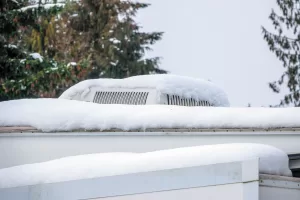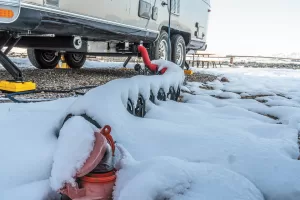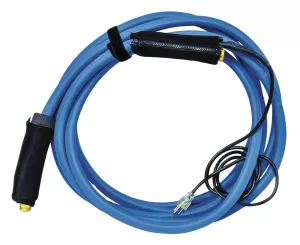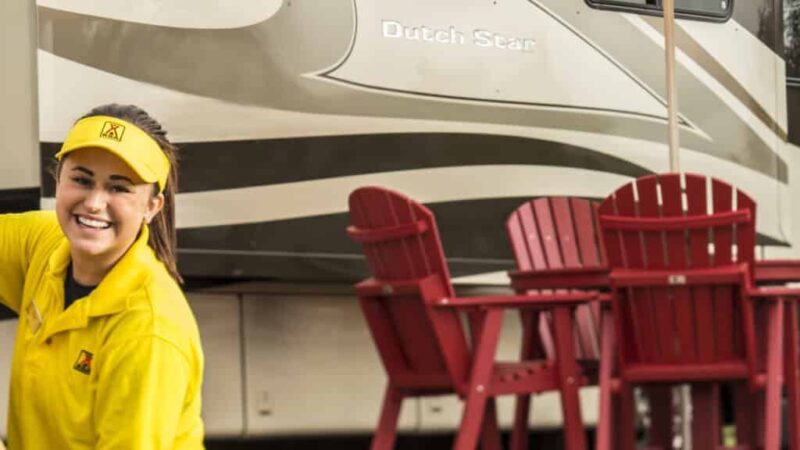Winter RVing
With proper planning, RV use in cold climates can be fun!
By Chris Dougherty, F263059
January 2024
There was a time when, for most people, the thought of living in an RV during the winter in a cold-weather climate seemed unfathomable. Being a mechanical rebel, I decided to subject an RV to cold Northeast winter conditions, and I hoped to do so without freezing up or dealing with discomfort.
I succeeded to a point. From 1998 to 2008, I was a full-time RVer who spent most of the winters in the Hudson Valley of New York. A digital indoor/outdoor thermometer informed me of the extremes, and the coldest temperature it recorded was minus 26 degrees Fahrenheit. The motorhome never froze up — at least when everything was working right!
That said, it cost a fortune to keep the unit warm. Although the Type A diesel had modifications to make it more winter-friendly, it suffered from condensation in the roof space (which was unvented, unlike many similar RVs today), as well as damage from mice. So, while living in the RV during the winter in the Northeast did, in fact, work, the expense over the long haul made it undesirable.
But during that process, I learned much about RV construction, insulation, systems, and energy usage. I had the opportunity to gather facts about the practicalities of winter RV use and since then have applied them to newer, more modern RVs, some of which claim to be “four-season capable.”
THE USE CASE
Owning an RV isn’t inexpensive. Besides the initial purchase price, taxes, and fees, owners incur expenses related to maintenance, storage, and use of the unit. And its use and upkeep involve a fair amount of labor. RVers make a conscious decision to spend their discretionary funds on this form of travel instead of other types of vacations and recreation. This all factors into how an RVer feels about the lifestyle and their personal “cost-benefit analysis.”
So, it is no wonder that folks in the northern parts of the continent who end up storing their RVs for up to half the year might be interested in finding a way to use the RV during the off-season; more camping nights equals a lower average cost per night, and thus a better value.

Carefully remove snow accumulation from an RV roof using a plastic-bladed roof snow rake.
Of course, the adventure itself also provides value. Part of the allure of the RV lifestyle is having new experiences, and winter RVing certainly fits into that category. Being cozy in a capable RV while Old Man Winter dances inches away is a fun experience. Partaking in nature and outdoor sports with an RV in winter can bring a whole new level of enjoyment.
WINTER: THE ANTAGONIST
Winter RVing is not without its challenges, and the more you understand those hurdles up front, the better prepared you will be, resulting in a more enjoyable experience.
Just like excessive heat, excessive cold can cause devices to malfunction and can be uncomfortable, or even deadly. Our RVs provide a portable shelter, so if the weather falls outside the range of what we deem safe and comfortable, we can move if we choose or need to. Driving straight into the heart of the meteorological beast is not necessarily a great idea with any vehicle, but it’s a gray area, and in the end, you must make the call as to whether the RV and you will do well.
While many RVs built today have at least some level of extreme weather capability, making sure they can handle a given environment is, at the end of the day, up to the RV owner, not the manufacturer.
To be clear, most RVs cannot maintain comfort and a working water system in below-freezing conditions without some modifications. Some are better than others, but knowing what to look for in build, design, and features can give you an idea of how the unit will perform.
CONSIDERATIONS FOR WINTER RVING
RV construction. RVs are not all built the same. While this may seem like common sense, the marketing of some RVs when it comes to cold-weather capability may give buyers the wrong idea. Understand that manufacturers rarely test RVs in freezing conditions. A “four season” sticker on an RV may not mean much; winter in Fort Myers, Florida, or Palm Springs, California, is very different from winter in Fargo, North Dakota.
RVs have one of two basic construction designs: a wood frame with a hung aluminum or fiberglass exterior, or a laminated-aluminum frame wall with a fiberglass exterior. Either type of construction can be used for a cold-weather RV, but is one better than another?
How the RV is insulated is critical. Heat transfer is a downside to all laminated RV wall construction. Metal tubing that gives the structure rigidity is glued to both the outside and inside panels simultaneously. This transfers heat through the structure, resulting in cold walls that often have frost from condensation where the metal tubing is. RVs whose manufacturers fill the tubing with wood still experience some of that transfer.
While wood framing would seem to be a better solution, the strength of those types of walls isn’t ideal in most cases, and aluminum siding adds to the heat transfer into the often poorly insulated wall and roof spaces.
Add a lot of metal-framed, single-pane windows; large automotive windshields on motorhomes and some trailers; and generally inefficient propane furnaces, and you’re heating the outdoors!
So, what is the best RV for winter use, and how does one shop for it?
RV and component manufacturers have been working on improving the thermal behavior in RVs and designing heating, ventilation, and air-conditioning (HVAC) systems that more efficiently and evenly heat and cool an RV. Truma, for instance, has a substantial drive-in environmental chamber at its facility in Elkhart, Indiana, that can be used by research and development engineers to study these effects.
What follows is a guide to the features and components that an RV needs for continual cold-weather operation. If your current RV or one you are considering purchasing doesn’t have these features, note that some can be installed or modified in the aftermarket. However, the basic structural and utility design is difficult or impossible to change after an RV is built, so it’s better to make some choices before purchase.
If a manufacturer labels an RV as an “all season,” “all weather,” or “four season” unit, request details from the company on how that has been accomplished. Salespeople rarely know this information, so factory reps are often a good source. If the factory people can’t answer these basic questions, then there’s likely nothing to discuss.
WINTER RV FEATURES
Structure. Regardless of construction style, as a rule, the thicker the walls and roof, the better the insulation value. Notice I didn’t say R-value. R-value means little in RV land, because of the variability in wall materials. For instance, the metal window frames and the inner metal wall structure will make a notable difference. If a manufacturer claims to use “special insulation,” obtain as much information about it as possible and research the product.
Beware of “heated and insulated underbelly” claims. The space between the frame rails is challenging to insulate and seal up. According to the brochure for my higher-end fifth wheel, it came with a “fully enclosed underbelly with one-piece fluted polypropylene with Astro-Foil insulation below the holding tanks.” The Astro-Foil reflective insulation is laid atop the corrugated plastic underbelly. The steel is uninsulated and has big, wide openings for slides, etc. There is a large open space between the floor and the Astro-Foil. It could be argued that more insulation in the underbelly invites water damage from road spray, but other manufacturers have successfully created a more tightly sealed underbelly.
Sometimes holding tanks come with an insulation wrap and heating pads; or, the tanks may have a small heat duct pointed in their general direction. It’s worth understanding how things are put together.
Windows. Dual-pane windows make a difference. I have argued this point with folks, but I have personally compared single-pane and double-pane windows in hot and cold conditions.
The biggest issue with RV windows is condensation, matched with heat loss from energy absorption by the subfreezing air outside. RV and automotive windows do a great job of keeping rain and wind out, but they also transfer heat remarkably well. Single-pane glass combined with metal frames makes for uncomfortable conditions in extremely hot or cold climates.
RV dual-pane windows simply consist of two glass panes glued together with a separator. The air space is not filled with argon or anything like that, but adding this gap between the panes of glass is a huge help. The metal frames will still transfer heat effectively, but the amount of condensation is vastly reduced in most cases. A search on YouTube for RV dual-pane windows will bring up a recent test by Big Truck Big RV that, with this article, should clear up any misunderstandings about use of these windows in RVs.
Window insulation kits supplied by companies such as Frost King are an option, but in my experience, the tape doesn’t stick well to the aluminum frames, even when the frames are cleaned ahead of time with alcohol. You also lose the ability to ventilate the interior, which is essential to keeping the humidity and condensation down.
It can be beneficial to use Astro-Foil or other reflective insulation in the windows, skylights, and vents. Sadly, this eliminates natural light and the ability to see outside, and winter is dark enough as it is. Unfortunately, there is no fix for windshields. The best bet is to seal them off while camped using curtains and insulated covers.
Heating and air-conditioning systems. The last motorhome I had while full-timing was equipped with a single 40,000-Btu gas furnace. I had to rebuild the furnace every year, which included a burner, fan motor, seals, and some hardware to hold the sheet metal together. The components were not built for a 100 percent duty cycle. That said, RV propane furnaces have been redesigned since then, and other options exist as well, such as hydronic heating systems, including the Aqua-Hot and Oasis brands. If your RV doesn’t have an Aqua-Hot hydronic heating system, it may be possible to upfit it, albeit at a steep price including labor. But if you are an experienced DIYer, you may be able to do it yourself.
Hydronic heating is ideal for RVs in cold conditions. These systems utilize a propane, diesel, gasoline, and/or electric-element boiler to circulate boiler antifreeze through a system of pipes in the RV. The pipes pass through fan-powered heat exchangers and in-floor heating coils to provide multizone, even heating in all areas of the unit. The system also offers continuous domestic hot water in most cases. With diesel motorhomes, it can also provide engine preheating, and the engine cooling system reverses the process while underway to provide heating and domestic hot water.
Rooftop RV heat pumps are ineffective below about 40 degrees Fahrenheit for the most part. The outside heat exchanger, which becomes the evaporator in heat pump mode, is too small to extract significant heat from the cold environment. My experiences over the years have borne this out. An A/C heating element will take the chill out of the air, and the heat pump will warm the RV in temperatures down to the 40s, but not below. You will need a primary heating system for comfort in colder weather.
It is strongly recommended that you have a backup heat source and can winterize the plumbing system at a moment’s notice in the event of a heating failure in the RV. Do not use a cooking appliance but have a Mr. Heater-type radiant heat unit or electric heater available. Always use these with the utmost caution and follow the manufacturer’s instructions.

To use an RV plumbing system during freezing weather, all of it must be kept warm.
Plumbing. First, it is possible to stay in your RV during cold winter weather without using the plumbing system if you have other options for the potty, cooking, and bathing. To use the system in cold weather, heated air must find its way to all the plumbing in the RV. This can be the most challenging aspect. While higher-end motorhomes with hydronics will likely have a heat exchanger in the wet bay, other RVs may have only a heating duct from the furnace, or nothing at all. Many folks turn to heaters and lightbulbs to warm this area, which can be dangerous if not done correctly.
Wherever plumbing runs, potable water and waste must be kept above freezing. An RV water system with exposed waste valves, city or gravity water connections, or low-point drain valves is not usable below freezing without a high risk of damage.

A heated water hose such as this one from Valterra helps when electricity is available.
Heating the plumbing in cabinets or other areas with 12-volt-DC computer fans and vent registers is a common fix that can work well if designed correctly. Wet bays need to be heated. If the RV’s heat plant is insufficient, adding a separate heater may be an option, but extreme care needs to be taken to ensure safety from both a fire and electrical standpoint. Back in the day, some coach manufacturers used a “Back Seat Heat” 12-volt-DC heater in the wet bay, which was pretty ineffective given the poor insulation down in that part of the RVs. It was also a substantial DC amp user, which can be an issue while dry camping.
Tank heaters are a must for RVing in prolonged freezing weather. Regardless of the RV’s design, tank heaters are the only thing that will keep the holding tanks and piping free from ice when the temperatures drop below freezing.
If the RV has a large enough heated fresh-water tank, it is best to fill it and then disconnect the hose and put it away. Companies such as Camco, Pirit, and Valterra offer heated hoses that are safe and effective for keeping a city water connection operating as long as electrical power is available. However, winter storms can disrupt power in rural areas, and then if the temps are cold enough, the hose will freeze quickly. Of course, the source of fresh water must also be freeze-protected, whether electrically or via below-ground valves.
The above recommendations have one thing in common: They are energy intensive. A continual fuel and electricity supply is mandatory, especially when temperatures drop below the 30s. The system must work overtime if the outside temps stay below freezing for days or weeks. In my case, I employed an external propane supply via a 200-pound cylinder that was refilled by a vendor weekly.
Boondocking for any significant amount of time in these conditions with an operating water system is problematic. If you can run an auxiliary generator 24/7 and manage refueling, you’ll probably do okay.
Insulating underneath the RV and on top of slideouts. There is no question in my mind that protecting the RV from cold wind blowing underneath the unit makes a huge difference. However, do NOT use bales of hay, straw, or anything that animals may find attractive to nest in, or anything that collects water and freezes to the ground, requiring an excavator to dig it up to move the RV.
One portable option that might work well is AirSkirts (airskirts.com). Based in Connecticut, the company offers inflatable skirting designed to be installed under the RV while it is parked, creating a flexible air barrier and causing an effect similar to dual-pane windows. They reportedly can be set up in minutes and are held in place by air pressure. The trapped air serves as a natural insulator. While I have not personally experienced AirSkirts, the idea is a win.
Another option is vinyl skirting that can be made for your RV and installed using Velcro or similar hook-and-loop material, a track, or common-sense fasteners with something to hold them on the ground. A manufacturer called The Skirting Company (theskirtingco.com) makes insulated skirting kits especially for this purpose.
Foam-board insulation may sound like a good option, but the variability of an RV’s ground clearance and the lack of portability make this a less than optimum choice.
Slideout rooms add some complexity. An RV without slideouts will be much easier to handle in winter conditions. Slide rooms generally have thinner walls, floors, and roofs than the main body, which causes more heat loss. On top of that, slide rooms are sometimes held together by aluminum trim brackets with seals that further exacerbate heat loss. The flat roof of the slide will collect snow, and because of the minimal insulation, the snow could melt, causing ice dams and leaks. Then, try to get that off the roof to put the slide in for travel. Not fun.
Slide toppers are helpful if they are vinyl and don’t make contact with the roof of the box. For this, I like foam-board insulation, such as the pink stuff from Owens Corning Fiberglas. Cut to size, it will slide in from the end of the slide box between the topper and the roof, making a huge difference. Acrylic fabric toppers can freeze up, which can be problematic when retracting the slide. Vinyl allows the snow and ice to slide off, especially if the topper has been treated with a vinyl protectant.
Sealing up the RV. Most RVs have voids that will need to be addressed for winter RVing. Not only do openings allow heat to escape, but they also can permit critters to enter and leaks to occur.
A Sealtech RV leak test (rvleaks.com) is the best way to detect body voids that allow water intrusion during the winter. The roof seals must be strong and intact to prevent damage from melting snow and ice. You likely will end up with solid ice on top of the RV where the heat has melted the snow. Of course, removing snow from the roof as soon as possible after a storm is recommended. A plastic-bladed roof snow rake, used with care, works well.
The underside of the RV should have all voids sealed up. Spray foam insulation is a common solution and is fine unless mice are an issue. I have used hardware cloth set in spray foam to help keep the critters at bay. Mouse Free (mouse-free.com) is a Canadian product that also works well at keeping the mice away. Invented by an RV owner, it acts as an undercarriage lubricant that creates a thin protective coating that mice cannot travel across.
Be sure to seal anywhere mice can get in. This can be almost impossible in motorhomes if it wasn’t done at the factory, but do the best you can. Some people like using steel-wool pads around hoses, cables, and other voids, but they rust and corrode in time. Galvanized hardware cloth works well, as do other noncorroding metals.
Winter RVing is an adventure and a great way to experience fun cold-weather activities. If you own an RV, it’s worth trying out a small trip. If you enjoy the experience, you can add other outings and gain even more value from your investment.
WINTER PROPANE FACTS
Propane, or liquified petroleum (LP) gas, is a safe, efficient heating and cooking fuel. It is odorless and colorless when extracted and has mercaptan added to it, which produces its stinky odor. Propane is similar to butane, but butane’s boiling point is higher than propane. What makes propane desirable is that it can provide a lot of Btu for the size of the container. The propane is primarily liquid in the pressurized container, with some vapor at the top. Since propane boils at minus 44 degrees Fahrenheit, it will provide deliverable fuel for most environments that RVs encounter during use. However, the colder it gets outside, the lower the vapor pressure, which means it’s possible to “exceed the vaporization rate” with heavy usage. This means your furnace, for instance, may not work even though you have propane in the container.
The best way to counter this is to keep your containers more than 50 percent full and use larger containers if possible. Propane cylinder heaters are also available if needed.
The post Winter RVing appeared first on Family RVing Magazine.



